2007 Salary Survey: Additional Charts & Analysis
Here you’ll find additional charts and analysis that we could not fit into our December Salary Survey issue.
Click here for the rest of our survey results. And if you still don’t see what you need, e-mail us at
[email protected], and we’ll review your request for publication in our Stats column year-round.
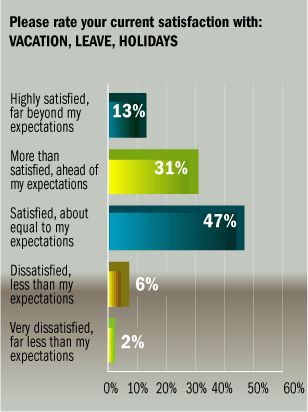 Satisfaction With Time Off for Vacation, Leave, or Holidays
Satisfaction With Time Off for Vacation, Leave, or HolidaysThe vast majority of respondents are satisfied with the time they have for vacation, leave, or holidays, with only 8 percent filing into the ranks of the dissatisfied or very dissatisfied. This statistic may also have implications for the respondents’ attitudes toward time off relative to dedication to their careers and to their fields of work.
The vast majority of respondents are satisfied with the time they have for vacation, leave, or holidays.
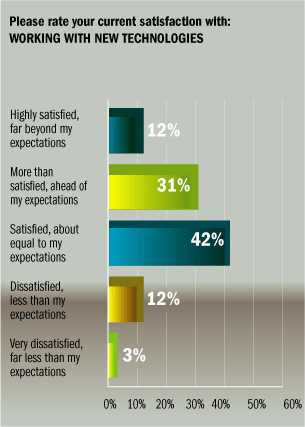 Satisfaction With Working With New Technologies
Satisfaction With Working With New TechnologiesWorking with new technologies offers substantial satisfaction for respondents overall, with 85 percent reporting they are satisfied, more than satisfied, or highly satisfied. Still, only 12 percent of all respondents said they are highly satisfied in this aspect of their career—surprising for a profession where new technologies reputedly have impact.
Only 12 percent of all those responding said they are highly satisfied about working with new technologies; surprising for a profession where new technology reputedly has impact.
The largest proportion of responses for each institution type falls in the mid (“satisfied”) range, with far lower percentages in the “highly satisfied” range for all institution types. The lowest “highly satisfied” bar registers 10 percent in the for-profit/other institution type, with a not-much-higher 14 percent for both 2-year private/public colleges and vocational/technical colleges.
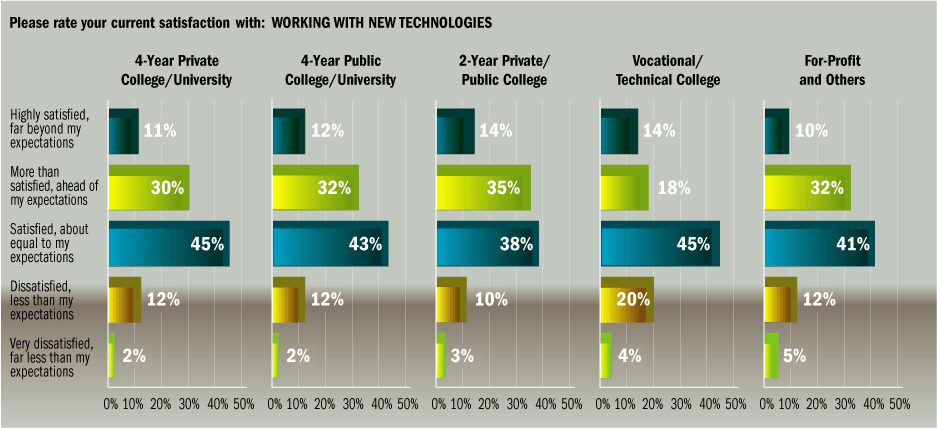
No institution type offers the ‘far beyond expectations’ we might hope for in a profession working with IT.
But no institution type offers the “far beyond expectations” we might
hope for in a profession working with information technologies. At
least we’re seeing 2-5 percent responses in the “far less than my
expectations” range.
Satisfaction With Work ResponsibilitiesIn the realm of work responsibilities, the vast majority (88 percent) of respondents indicated they are satisfied, more than satisfied, or highly satisfied. While that’s a nice, large percentage, what can we do about the full 12 percent who are either dissatisfied or very dissatisfied in such a key area as work responsibilities? As for the differences evident between males and females who hold technology-related posts across the campus, the numbers run neck-and-neck, except for the slight disparity in how “thrilled” respondents are (women are somewhat less apt to feel satisfied beyond or well beyond expectations in the area of work responsibilities), and the greater disparity when it comes to out-and-out dissatisfaction: Four percent of women are more dissatisfied than men.
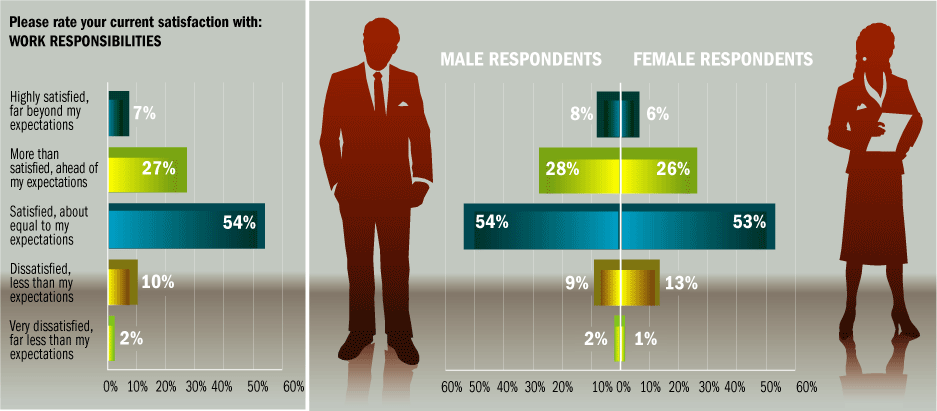
What can we do about the full 12 percent who are dissatisfied in the key area of Work Responsibilities?
An analysis by institution type offers few clues about those dissatisfied with their work responsibilities. The 12 percent in the combined “dissatisfied” or “very dissatisfied” ranges remains consistent except in the “for-profit and others” institution type, where we see a small 3 percent increase. But the “for-profit and others” institution type also earned the lowest percentage in the mid-range “satisfied, about equal to my expectations” bar, at 48 percent. That’s a full 12 percentage points lower than the highest percentage shown in any bar in the chart, the 60 percent mid-range “satisfied” mark earned by 4-year public colleges and universities.
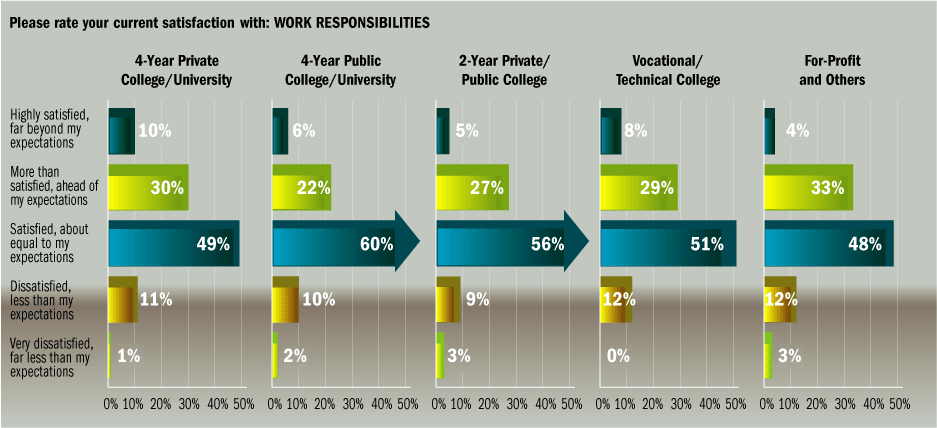
The highest percentage on the chart: the 60 percent “satisfied” mark earned by 4-year public colleges and universities.
Across males and females surveyed, more than one third of all respondents (36 percent) have had 5 to 24 years of experience outside of the academic setting, with the preponderance of those respondents (21 percent) reporting 10 to 24 years in the business world. This says to us that colleges and universities may be becoming more savvy about recruiting expertise from the corporate world, although we certainly wish we had previous baseline statistics for comparison purposes. Forty-one percent of respondents have had no experience outside of the academic environment, but although this is a sizable number, it still comes in under the 59 percent who hail from “outside.” It will be interesting to see how the numbers change over the years: College and university administrators may be becoming more adept at pulling expertise from the corporate world, but with the number of technology advancements that are being spawned by the academic world (not to mention the need to keep up with and even anticipate student expectation), higher-ed-trained technologists are becoming increasingly sophisticated each day. What is not so surprising, however, is the male vs. females response: Although in both cases, 20 percent have come from inside the academy, the breakdown of time outside the academic environment indicates that more men than women hailed from the outside world at one point, and the average length of experience in the business world tends to be a good deal longer for men than for women.

More men than women hail from the outside world, and the average length of experience in the business world tends to be a good deal longer for men than for women.
About the Author
Rhea Kelly is editor in chief for Campus Technology, THE Journal, and Spaces4Learning. She can be reached at [email protected].